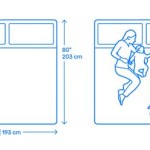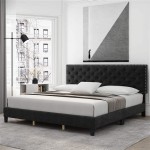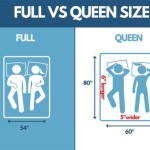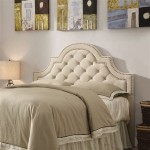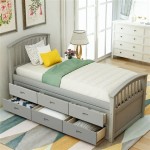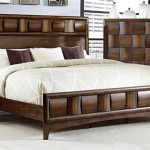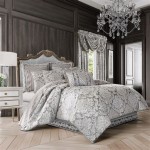Selecting the Right Rug Size Under a Full-Sized Bed
Choosing the correct rug size to place under a full-sized bed is a crucial element in interior design. A well-proportioned rug can significantly enhance the aesthetic appeal of a bedroom, adding warmth, texture, and visual cohesion. Conversely, an incorrectly sized rug can make the room feel disjointed and unbalanced. This article will explore the various options and considerations when determining the appropriate rug dimensions for under a full-sized bed.
A full-sized bed, also known as a double bed, typically measures 54 inches wide and 75 inches long. The rug size should ideally extend beyond the perimeter of the bed to create a comfortable and visually appealing floor covering. There are several common approaches to achieving this, each with its own advantages and design implications. The chosen approach will depend on the room’s layout, the presence of other furniture, and the desired aesthetic.
Considering Standard Rug Sizes and Placement Options
The most common rug sizes employed under full-sized beds are 5'x8', 6'x9', and 8'x10'. The selection among these sizes hinges on the desired coverage and the overall room dimensions. The placement strategy also directly influences which of these sizes is most suitable.
Option 1: The Floating Rug. This approach involves placing a smaller rug, such as a 5'x8' or 6'x9', centered under the lower two-thirds of the bed. The rug will extend from the foot of the bed towards the headboard, leaving the area under the nightstands exposed. This strategy works well when space is limited or when highlighting hardwood flooring. The main benefit of this approach is its cost-effectiveness and ease of placement. However, it provides less underfoot comfort when getting out of bed.
When selecting the floating rug method, precise measurement is still crucial. The rug should extend far enough beyond the sides of the bed to provide a comfortable landing spot for feet upon rising. A minimum of 18-24 inches on each side is generally recommended. If the rug is too small, it will appear insignificant and fail to contribute positively to the room's design.
Option 2: The Extended Rug. This approach uses a larger rug, such as an 8'x10', placed under the bed so that it extends beyond the sides and foot of the bed. Typically, the rug will extend approximately 18-36 inches beyond the sides and foot of the bed. The headboard of the bed can either sit on the rug or rest just beyond it, depending on the desired aesthetic and room layout. This method offers significant underfoot comfort and creates a more luxurious and grounded feel in the bedroom.
This larger rug size effectively anchors the bed and surrounding furniture, creating a visually cohesive and unified space. The extended rug approach is especially well-suited for larger bedrooms where a smaller rug might appear lost or insignificant. Furthermore, it provides ample space for placing nightstands partially on the rug, further integrating them into the overall design.
Option 3: The Full Coverage Rug. In this approach, the rug is large enough to encompass the entire bed and nightstands, extending significantly beyond all sides. This option requires a very large rug, often 9'x12' or larger, and is best suited for spacious bedrooms where ample floor space is available. The full coverage rug creates a luxurious and opulent feel, maximizing underfoot comfort and defining the entire sleeping area.
The full coverage approach necessitates careful consideration of the room's overall dimensions. The rug should not extend too close to the walls, as this can make the room feel cramped and overwhelming. A border of exposed flooring around the perimeter of the rug is generally recommended to maintain a sense of spaciousness and balance. This approach is the most expensive, but the visual impact is undeniable.
Each option provides a distinct aesthetic and functional benefit. The best approach depends on the specific room, budget, and desired level of visual impact. Careful consideration of these factors will ensure that the chosen rug size complements the bed and enhances the overall design of the bedroom.
Factors Influencing Rug Size Selection
Beyond standard sizing and placement, several additional factors influence the selection of the optimal rug size for under a full-sized bed. These include the room size and shape, the existing furniture arrangement, the desired aesthetic, and the budget.
Room Size and Shape: The dimensions of the bedroom are a primary determinant of the appropriate rug size. In a smaller room, a large rug can overwhelm the space, making it feel cramped and confined. Conversely, in a large room, a small rug can appear insignificant and out of proportion. The room's shape also plays a role; an irregularly shaped room may require a custom-sized rug to achieve optimal coverage and visual balance.
Measurements should be taken carefully to determine the available floor space and to ensure that the rug will fit comfortably without crowding other furniture or obstructing doorways. Consider the traffic flow within the room and ensure that the rug does not create any tripping hazards or impede movement.
Existing Furniture Arrangement: The placement of other furniture, such as nightstands, dressers, and chairs, will influence the ideal rug size and placement. If nightstands are positioned beside the bed, the rug should ideally extend far enough to accommodate them partially or fully. This helps to visually integrate the nightstands with the bed, creating a cohesive and unified arrangement. Similarly, if there is a seating area within the bedroom, the rug should ideally extend beneath the furniture to define the space and create a sense of enclosure.
Consider the overall layout of the room and how the rug will interact with the existing furniture. Avoid placing the rug in a way that obstructs walkways or creates visual clutter. The goal is to enhance the room's functionality and aesthetic appeal, not to create obstacles or distractions.
Desired Aesthetic: The desired aesthetic of the bedroom will also influence the choice of rug size and style. A minimalist bedroom may benefit from a smaller, understated rug that provides a subtle touch of texture without overwhelming the space. A more opulent or luxurious bedroom may call for a larger, more elaborate rug that serves as a focal point and adds visual richness.
Consider the overall color palette and design style of the room when selecting a rug. The rug should complement the existing décor and enhance the overall aesthetic. Pay attention to the rug's color, pattern, and texture to ensure that it harmonizes with the other elements in the room.
Budget: Rug prices can vary significantly depending on the size, material, and construction. Larger rugs generally cost more than smaller rugs, and rugs made from natural fibers like wool or silk tend to be more expensive than those made from synthetic materials. Before selecting a rug size, it is essential to establish a budget and to consider the trade-offs between size, quality, and price.
Explore different options and compare prices to find a rug that meets your needs and fits your budget. Consider purchasing a rug pad to protect the rug and extend its lifespan. A rug pad can also provide additional cushioning and prevent the rug from slipping or sliding.
Material and Style Considerations
The material and style of the rug are also important factors to consider when selecting a rug for under a full-sized bed. The material will affect the rug's durability, comfort, and maintenance requirements, while the style will determine its visual impact and how well it complements the room's decor.
Material Options: Common rug materials include wool, cotton, synthetic fibers (such as nylon and polyester), and natural fibers (such as jute and sisal). Wool rugs are known for their durability, softness, and stain resistance. Cotton rugs are more affordable and easier to clean, but they may not be as durable as wool rugs. Synthetic rugs are a cost-effective option and are often resistant to stains and fading. Natural fiber rugs add a rustic and textured element to the room, but they may not be as soft or comfortable as other options.
Consider the level of foot traffic in the bedroom and the amount of maintenance you are willing to perform when selecting a rug material. Wool rugs are a good choice for high-traffic areas, while cotton rugs are better suited for low-traffic areas. Synthetic rugs are a good option for those who want a low-maintenance rug, while natural fiber rugs are a good choice for those who want a more eco-friendly option.
Style Considerations: Rug styles range from traditional and ornate to modern and minimalist. The style of the rug should complement the overall decor of the bedroom. A traditional bedroom may benefit from a Persian or Oriental rug, while a modern bedroom may benefit from a geometric or abstract rug. A bohemian bedroom may benefit from a brightly colored or patterned rug.
Consider the color palette of the bedroom when selecting a rug style. The rug should complement the existing colors in the room and enhance the overall aesthetic. You can choose a rug with a similar color scheme to the room or a rug with a contrasting color scheme to add visual interest.
The ultimate choice of rug size beneath a full-sized bed represents a balance of practicality, aesthetic preference, and budgetary constraints. By carefully considering the room's dimensions, furniture arrangement, desired visual impact, and available budget, one can select a rug that not only enhances the room's beauty but also provides comfort and functionality for years to come.

This Is What Diffe Area Rugs Will Look Like Under Your Bed

What Size Rug Should I Use Under A Bed Mcqueens Interiors

Rug Size Guide For A Bedroom

Bedroom Rug Sizing Guide

Bedroom Rug Placement Guide

Rug Size Guide At Home In The Valley

Everything To Know About Placing A Rug Under Your Bed

Bedroom Rug Over Carpet Honey We Re Home

How To Choose The Best Rug For Under Your Bed 136 Home

Rug Under Bed Sizes King Queen Double Child Images Bennetts Carpets

